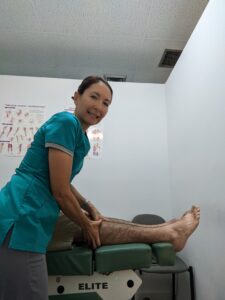
The chiropractic approach to the treatment of running injuries involves a thorough understanding of the anatomy, biomechanics, motor patterns, and kinetic chains of the lower extremity (limb), including the pelvis. Your kinetic chain is a combination of several successively arranged joints. These joints constitute a complex unit, as links in a chain.
By identifying the underlying problem or dysfunction, your chiropractor can implement a multilevel treatment protocol (detailed plan) that involves chiropractic manipulative therapy. A chiropractic realignment will restore faulty biomechanics. Lastly, your chiropractor can prescribe exercises to strengthen weakened muscle groups and motor pattern re-education.
The following are 3 common runner’s lower extremity injuries chiropractic can help.
1. Achilles Tendonitis
The achilles tendon is a very large tendon which connects the gastronemius and soleus (calf muscles) to your calcaneus (heel bone).
The Achilles tendon is covered by a peritenon (connective tissue sheath surrounding a tendon) composed of mainly areolar tissue (fatty tissue) which functions as a cushion. The area most affected in tendinitis is approximately 2 cm proximal (close) to the calcaneal insertion (heel attachment). The demands on the tendon are high in running and jumping.
Next, at the heel insertion (attachment site) there can be a complicating problem. The retrocalcaneal bursa (small cushioning sac between the heel bone and the achilles tendon) can get irritated. Eventually, this may lead to a Haglund’s deformity (bony enlargement found on the back of the heel).
Common symptoms of achilles tendonitis include a dull pain above your heel, swelling along the tendon, or a limited range of motion when you try to flex your foot toward your shin.
Have your chiropractor treat your Achilles tendon right away when you begin to feel pain. Otherwise the risk of rupturing it increases. Then you will need surgery and months of recovery will delay your training and running.
2. “Runner’s Knee”
Runner’s Knee is also called patellofemoral syndrome or chondromalacia patella. It is seen in various athletes, but most commonly seen among runners. You may have anterior (front) knee pain. However, your knee pain may be found behind, in and around your patella (knee cap) as well. It may be vague aching pain that is aggravated by going up and down stairs. Moreover, there may be associated crepitus (cracking or grating) and knee pain going through any squatting maneuver.
Certainly, biomechanical (study of living body) abnormalities can lead to an erosion and fragmentation of the sub patellar (beneath kneecap) cartilage. This breaking up of the patella articular cartilage due to repetitious stress leads to chondromalacia. So patella tracking problems can occur primarily from injuries to the knee and quadriceps (group of four muscles that cover the front and sides of your thighs) mechanism. And it can secondarily be in response to problems affecting the ankle or hip. Your chiropractor can diagnose your knee problem, assess and realign your spine, hip, knee and ankle.
3. Hamstring Strain or Adductor Strain/Sprain (Groin Pull)
Perhaps you were running, sprinting or jumping and you over contracted the hamstrings while in a position of stretch? You may be a runner who feels a sudden pull or pop at the back of the thigh following a forceful knee extension maneuver?
The hamstrings are a group of three muscles that run along the back of your thigh. They allow you to bend your leg at the knee. Tendons and aponeurosis (a sheet of pearly white fibrous tissue) connect the muscles with the structures (i.e. bones ) to be moved. Strains (injury to muscle) of hamstrings occurs most often at the junction of the muscle and aponeurosis.
Perhaps you were sprinting or jumping and felt a sudden pulling sensation in the groin that was incapacitating? The adductors are a group of muscles on the inside of your thigh. So a sprain is an injury to the ligaments, a fibrous connective tissue that attaches bone to bone, and usually serves to hold structures together. And the cause of an adductor sprain (injury to ligaments) is often a sudden contraction from a stretched position.
While ice and rest from the inciting activity are a start. And you may try a drug for fast pain relief for the moment. This is not a long term solution. Get to your chiropractor if it’s not getting better.
What to expect on your visit for 3 Common Runner’s Lower Extremity Injuries Chiropractic Can Help
In addition to joint manipulation and adjustment to the spine and peripheral joints, at Meiri Chiropractic, we use soft tissue procedures, hot and cold modalities, stretching exercises, rehabilitation exercises, and homeopathic consultations.
At Meiri Chiropractic in West Palm Beach we spend the time necessary to examine, diagnose and treat every neuromusculoskeletal condition and various ailments you have. Through regular chiropractic visits, you can get pain relief and improve function. Chiropractic is a holistic and natural way to not only treat existing conditions, but to keep your body in its best working condition. Meiri Chiropractic has been offering effective chiropractic care in Palm Beach county since 2006. Many of our patient reviews note our excellence. Call us today at 561-253-8984 in West Palm Beach to make an appointment or to find out more about 3 Common Runner’s Lower Extremity Injuries Chiropractic Can Help.

